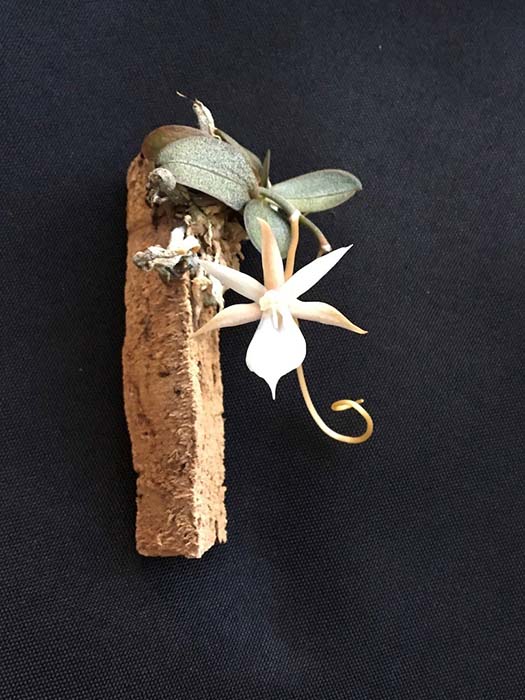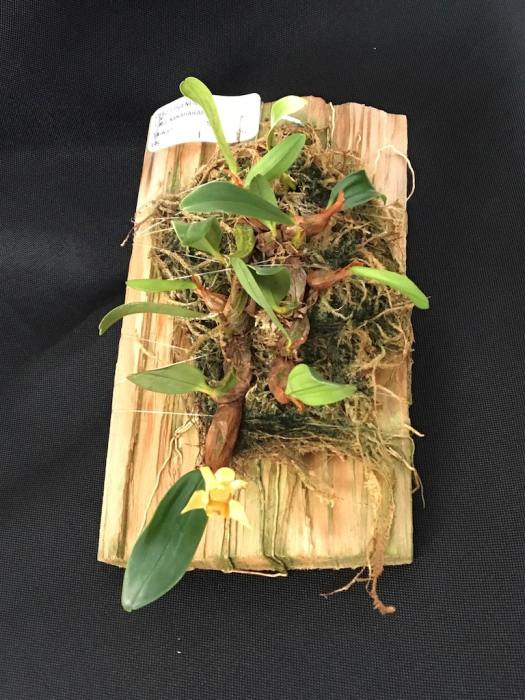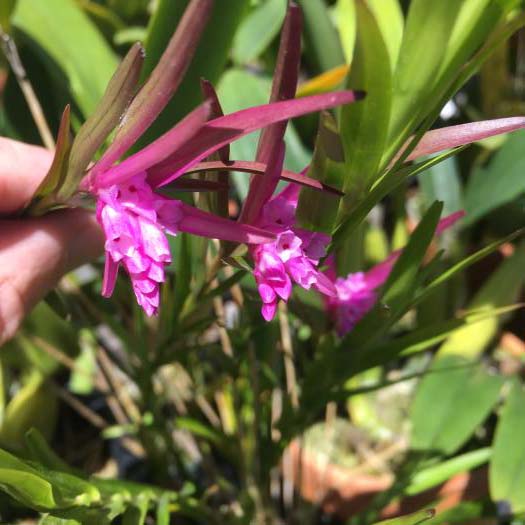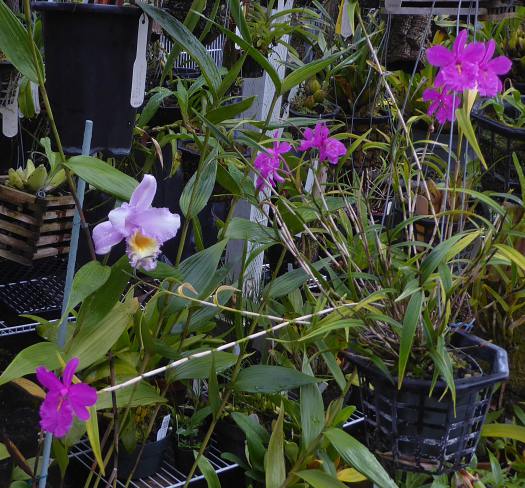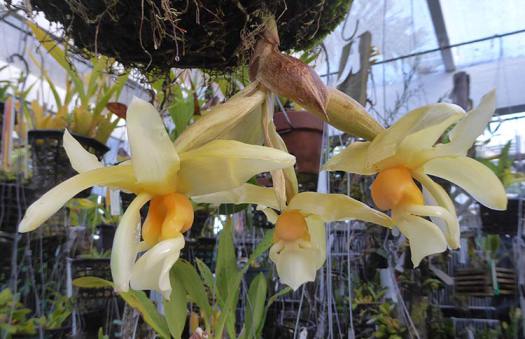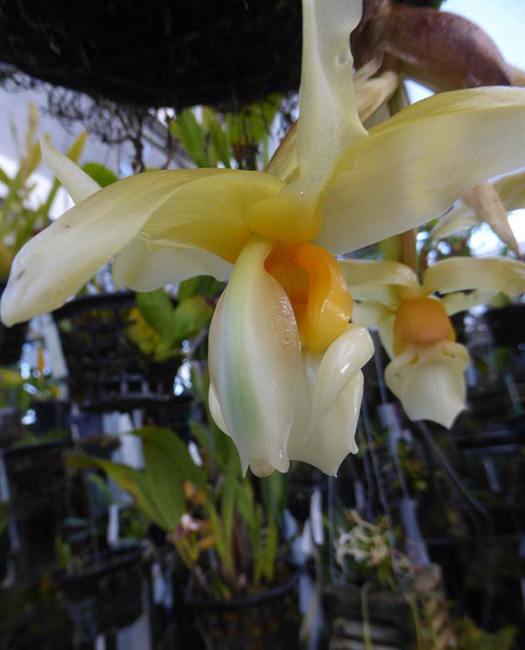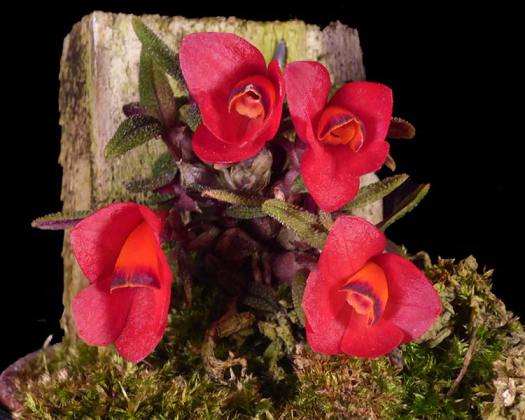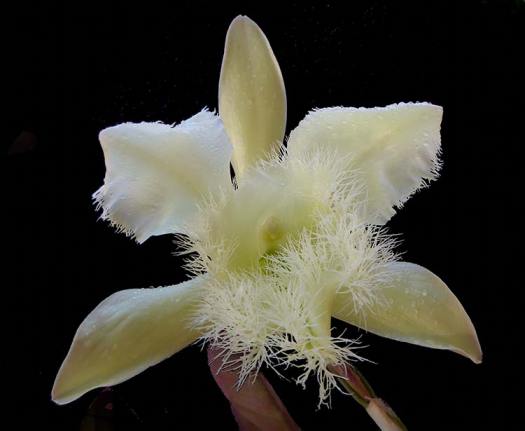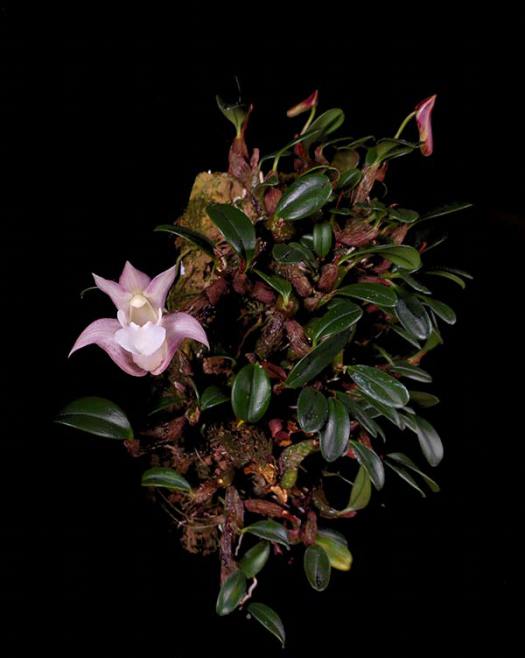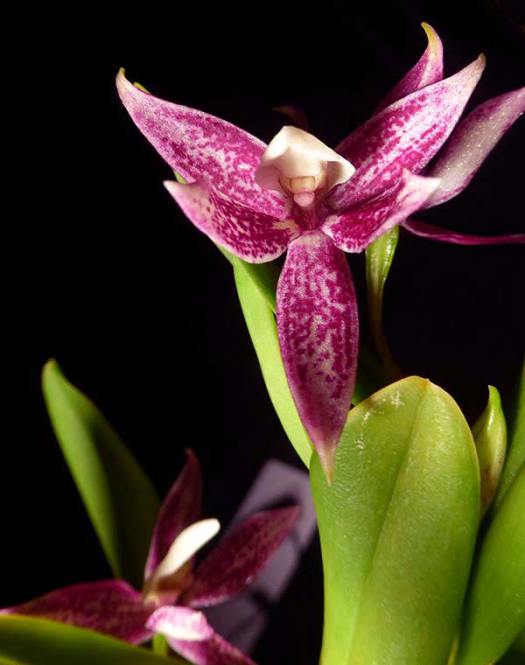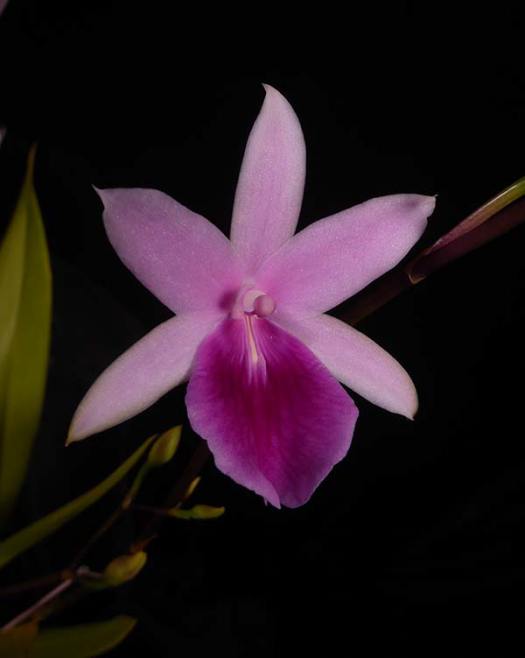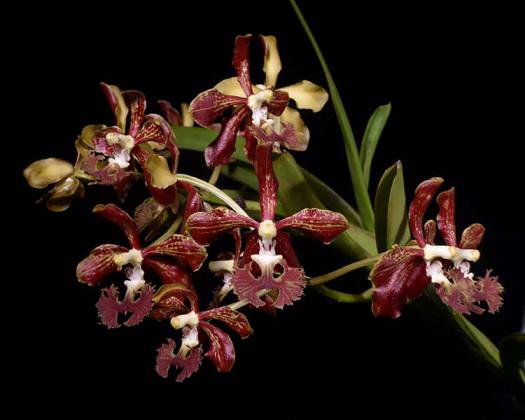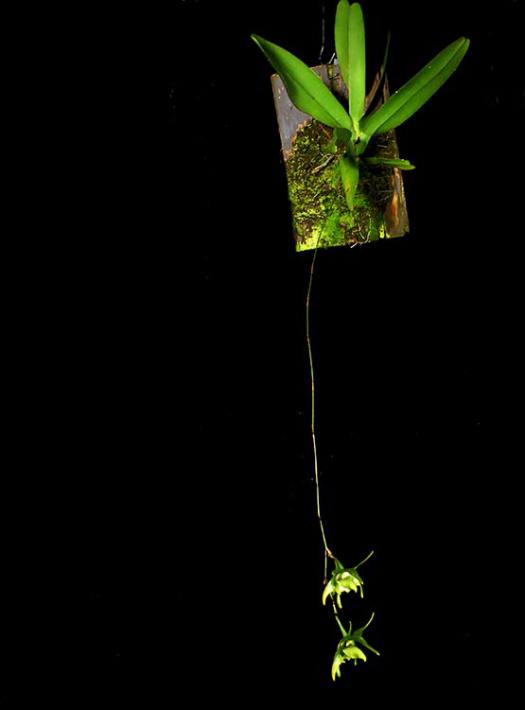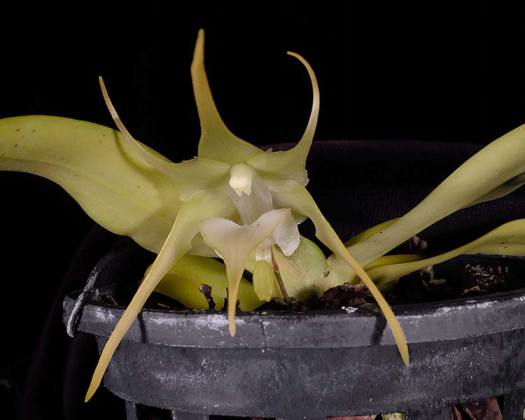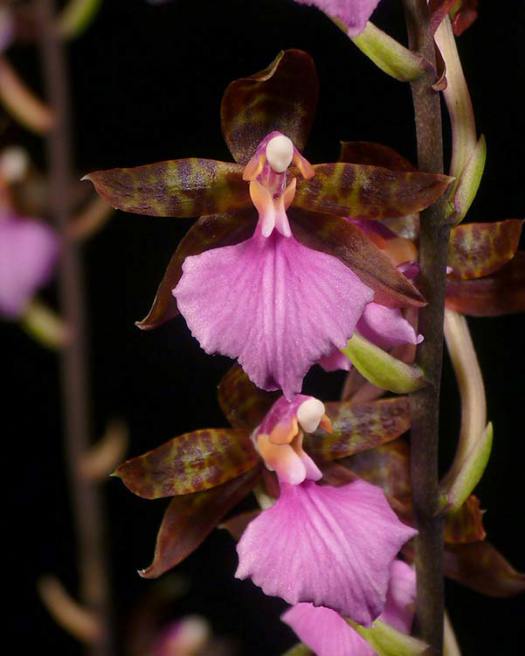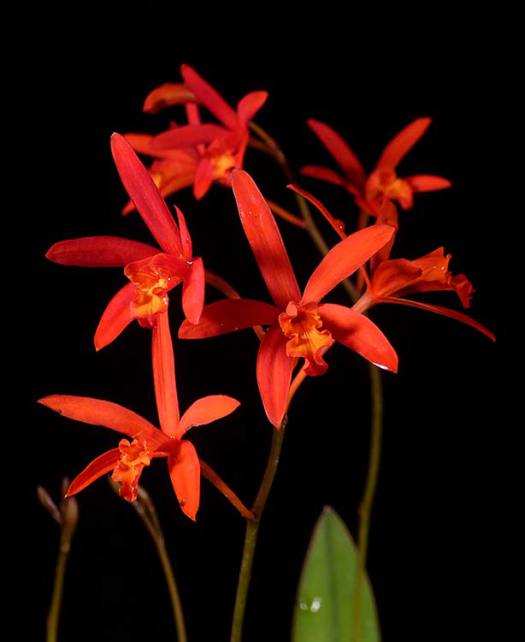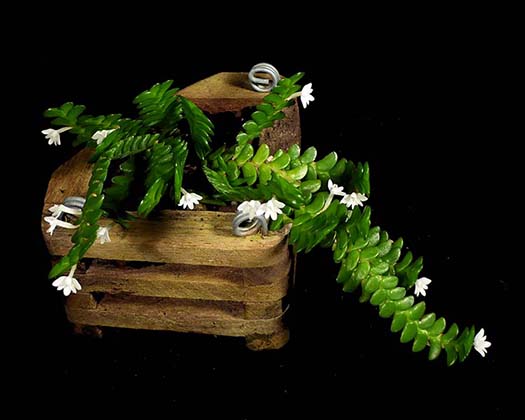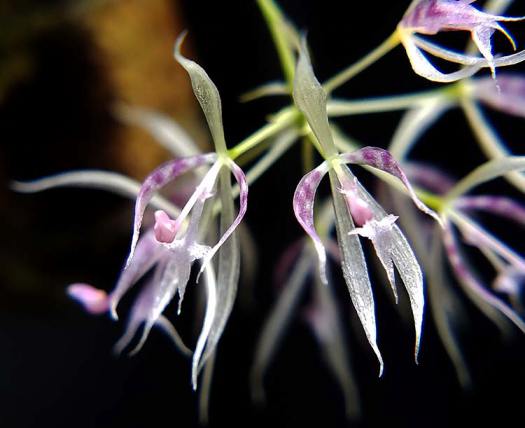October 2019 |
Show and Tell
From Cindy Jepsen:
|
|
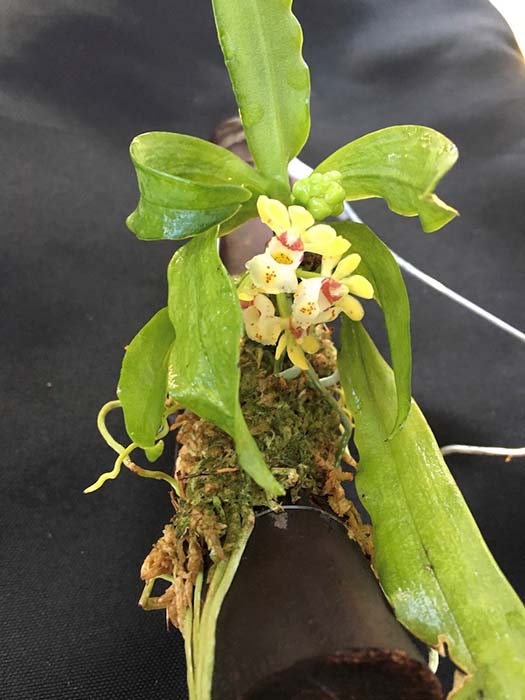
Gastrochilus japonicusI’ve had this species for about a year and this is my first bloom. As you can see, it has another cluster coming. It grows on the east side of the greenhouse hanging from a shelf. It loves a morning shower and high humidity. The bloom has stayed in good form for several weeks now. |
|
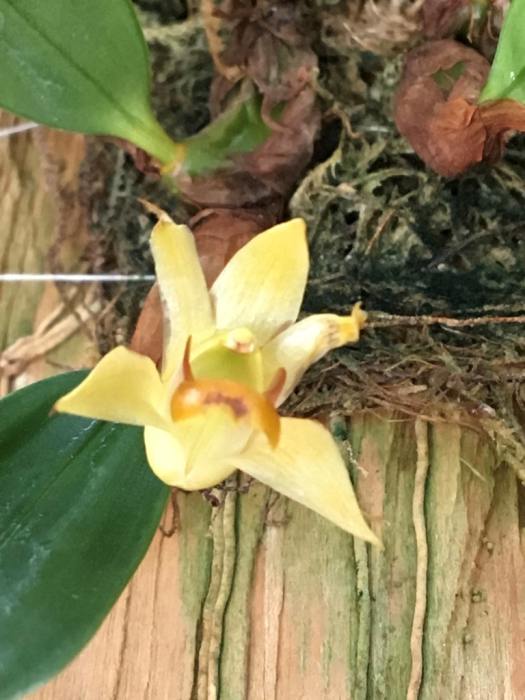 |
|
Epigeneium nakaharaeThis just bloomed for me again! This is a species from Taiwan that is tolerant of temperature and light. It sits low in my greenhouse and is up against an east facing window. I water it every day and feed it weekly with a rotation of MSU, Seaweed and Superthrive. |
|
From Scott McGregor:
|
|
Brassavola cuculataIf you’re tired of Brassavola nodosa, try this one, with long petals and sepals and a jagged lip. Nicely fragrant at night. |
Bulbophyllum tingabarinumA mini sporting bright flowers arranged in an umbel with long tails. |
Dendrobium glomeratum/crepidiferum/sulawesienseThis one goes by lots of names, but is worth owning for the 3” fully saturated magenta and orange crystalline flowers that bloom on old, leafless canes. The flowers last for months. From Papua New Guinea, it likes cool nights and good water, and is much easier to grow than its friends, such as D. cuthbertsonii or D. lawesii. |
Dendrobium papilio (floriferous form)Dendrobium papilio is available in two varieties, one labelled “large form” and the other “floriferous form”. Why choose though, I have both! This one is the “floriferous form” and blooms in late summer for me with half a dozen 3” white and pink flowers seemingly floating invisibly on wiry thin canes. The “large form” has fewer 5” flowers and blooms late Spring for me.
|
Dendrobium jiantianum (chapaense)Here’s an interesting summer-blooming Dendrobium with 8-12” upright canes covered with short stiff black hairs. I have two small plants—the one blooming now has white flowers with an orangey-pink throat, and the other plant appears to be a yellow-orange variant.
|
|
Dendrobium parvulum (delicatulum)OK, this species isn't for everyone. Besides being hard to grow, it is nearly microscopic, and if that wasn't enough to dissuade you, it is rare and expensive. Found in Sulawesi, Celebes and Papua New Guinea, this is a microminiature mat-forming species that requires bright light but cool temperatures, and good water. The most common form is white, sometimes with spots. Much rarer is a distinctly blue form, and I finally found the even more elusive red/pink form last year and just now it finally bloomed with a couple flowers and a bud yet to open. I had this fantasy that I would have red, white and blue all blooming at the same patriotic time in July, but alas, the white form seems to favor the Spring, blue the Summer, and this one blooms in Autumn! Pics of the white and blue forms are included for reference-I like the blue one best! |
|
Cattleya (Laelia) fidelensisThis one is a bit of a shy bloomer for me, but a pretty summer addition when it does bloom.
|
|
Lockhartia imbricataThe flowers aren’t impressive-- sort of like very small Oncidiums, but the plants have attractive braided canes that make the plant prettier than most when not in bloom. I have both L. oerstedii and imbricata—both bloom on and off all summer, but this one has alternating green and yellow in the braided leaves, giving it a variegated look. Easy to grow and nice to have in your collection.
|
Oerstedella (Epidendrum) wallisiiClosely related to Epidendrums, Oerstedella is a great genus for outdoor plants and O. wallisii is in bloom about 11 months of the year. A mature plant will have 5-10 long-lasting flowers at a time. They like even moisture throughout the year. |
Maxillaria sophronitisLove the bright red/orange color but have trouble growing Sophronitis? Try Maxillaria sophronitis instead! I have two plants, one blooms in early Autumn and the other early Spring, and the flowers are long-lasting, so many months of color. This cloud forest species from Venezuela and Columbia likes bright light and even moisture. |
|
Maxillaria regneliiMiltonia regnellii is a beautiful species that grows well outside and flowers reliably for me. I’ve had this plant for about 5 years now and this year it has 12 spikes, with 3” flowers opening successively so the plant stays in bloom from September through October or November. There are a number of hybrids made from this species that also do well and add some additional color, such as M. Totem Lake. |
|
Neobenthamia gracilisThis species from the grasslands of Tanzania is usually listed as a hot or warm grower, but seems to do fine for me outdoors. The 2-3’ bamboo-like canes and leaves are topped with an umbel of 1” white flowers with pink and yellow spots. I grow it in a blend of potting soil and cymbidium mix, and it likes full sun. It will bloom a couple times per year. |
|
Oerstedella (Epidendrum) schweinfurthianumThis brilliantly colored, orange and magenta flowering “bush” deserves a place in every California collection. It grows up to 3-4’ tall in a sandy/rocky terrestrial mix, and likes full sun. It blooms reliably every August through October (and sometimes until November or December), and is easy to grow. |
|
Pteroceras semiteretifoliumThis is a tiny but very cute mini from Vietnam that grows easily outdoors. As the species name suggests, the leaves are short and stubby. |
Symphyglossum(Cochlioda) sanguineumUsually blooms for me in mid-summer, blooming much later this year for some reason. One of the easier Cochliodas to grow (but needs good water) and the flowers are long-lasting. |
 |
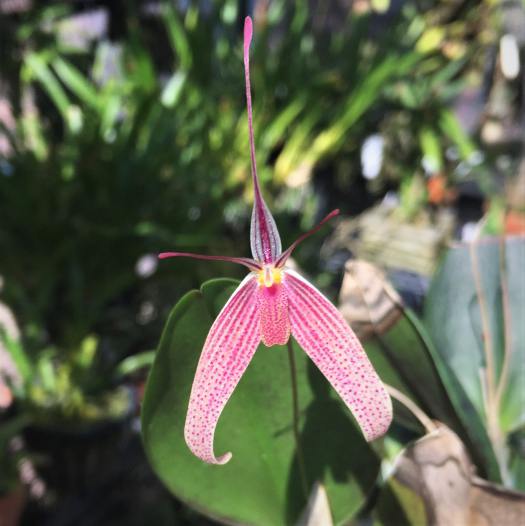 |
Restrepia chameleonThis one must be appropriately named “chameleon” because this year it bloomed with a “split lip” whereas it had a single fused lip in a pic of the same plant I took a few years ago. This is a fun genus, if you can give them cool and moist conditions with good water. |
|
From Roberta Fox:
|
|
Outside in the back yard - another prolific month |
|

Sobralia violaceaThis keeps getting better. These are four of the five flowers that I got on the plant at one time - two of the growths gave me doubles. Unfortunatly, flowers of each of these species only last one day, though they bloom sequentially. You just have to seize the moment, appreciate them at their best. |
|
 Dockrilia (Dendrobium) cucumerinumThe succulent leaves look like little gherkins, and the flowers are very intriguing. |
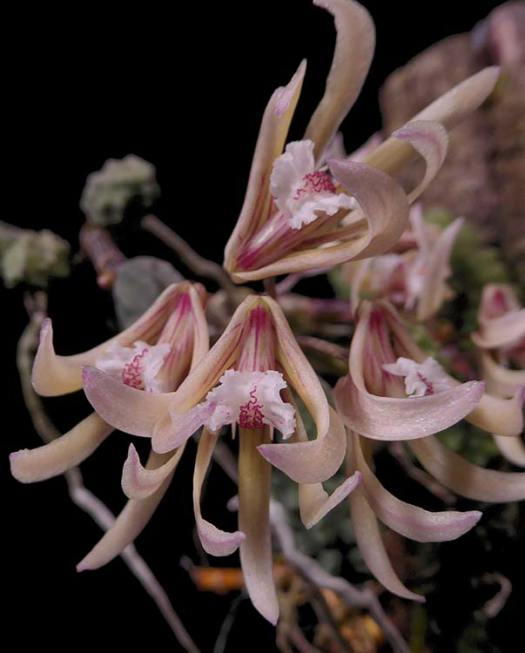 |
 Stanhopea intermediaThe flowers are so complex, one or two photos are insufficient. I got this plant several years ago from the photographer Ron Parsons. This is the first time that it has bloomed for me, and it very conveniently did so when Ron was here to speak at Cool Growing Orchid Society, so he got to see it. It took awhile for me to find a spot that was suffieciently shady and damp for my Sobralias. I have found that "damp" is particularly important. This has been a good year for them. |
|
 |
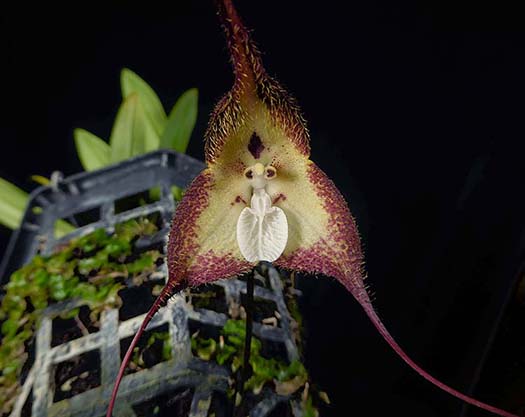 |
Dracula cordobaePerhaps the cool beginning of summer compensated for the heat that finally came in late august, but this has been a good year for Draculas. With the unbloomed spikes, there will be flowers for a month or so, even though the flowers are fairly short-lived, especially when it is warm. The best time for them is early morning when they are fully open. They collapse partially during the day, but reopen the next morning. |
|
 Epigenieum (Dendrobium) triflorum var. orientaleThis plant grows rapidly, and tends to climb out of its pot. I have one piece in a basket and one piece mounted. Both bloom regularly. The genus has been lumped into Dendrobium, but it may very likely be moved back out into its own genus. |
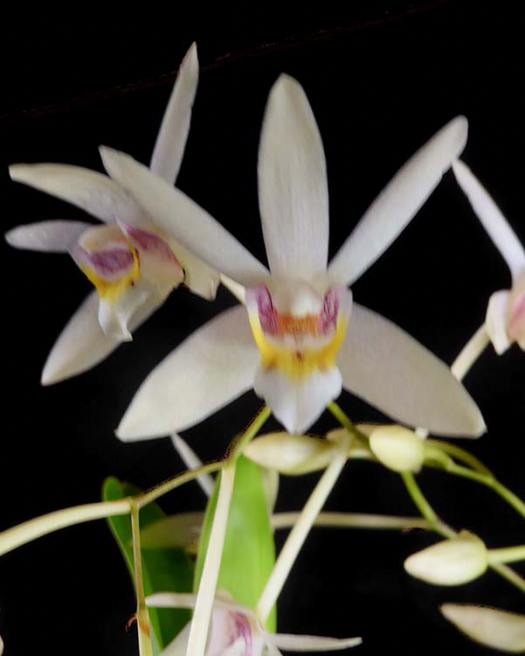 |
 Prosthechea (Encyclia) garcianaFlowers are quite long-lasting, 6 weeks or more. The color is most intense when they first open, then tends to fade. This plant has particularly saturated color for the species. |
|

Miltonia regnelli
|
|
 |
|
Vanda roeblingianaThis is a cold-tolerant Vanda with a very beautiful fringed lip. |
|
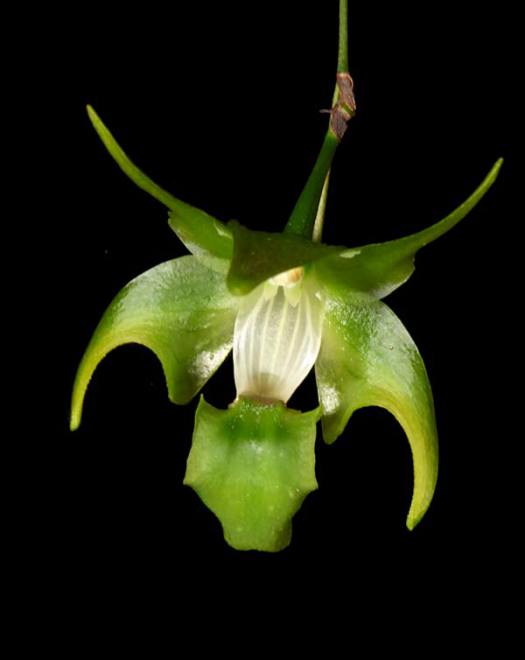 Aeranthes ramosaGrows shady and damp. Imagine those weird green flowers floating on a wire-thin inflorescence. I suspect that it is visible in a part of the spectrum visible to moths rather than humans. It is a sequential bloomer, so don't cut the spike until it fully dies back. |
|
 |
|
Aeranthes grandifloraThis one was a total surprise... the pot was labeled "Aerides falcata" ...oops. Fortunately it grows under similar conditions (outside, shady and damp). I love the weird flowers. |
|
Rhynchostele bictoniensisOr Lemboglossum bictoniense or Odontoglossum bictoniense. Spike is nearly 2 feet, flowers clustered in the upper 2/3. |
|
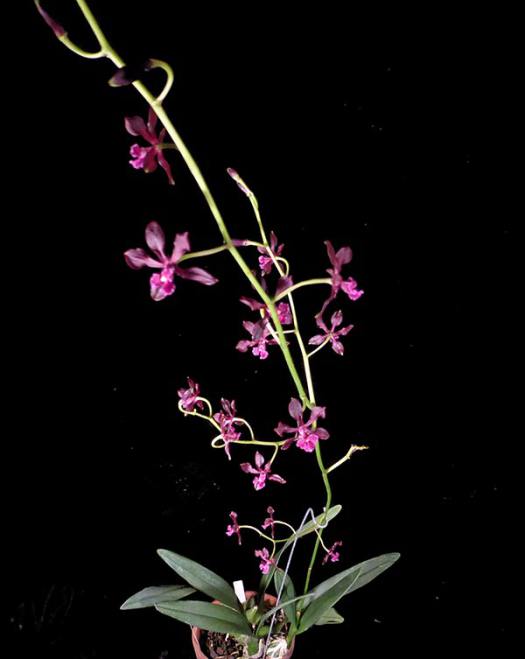 |
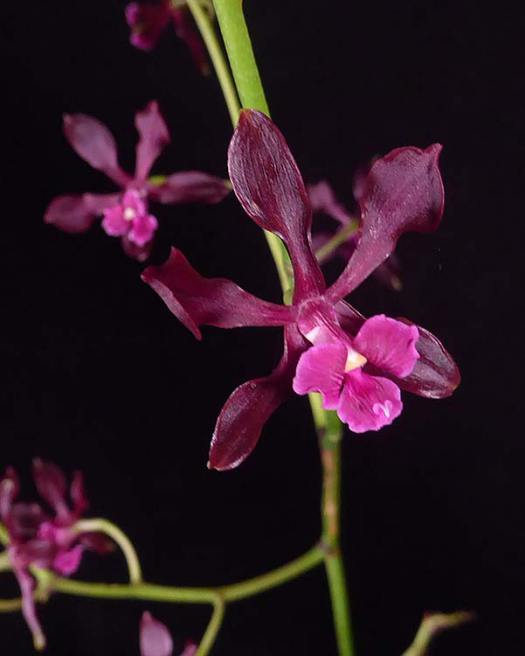 |
Encyclia atrorubensAnother tall one - spike is more than 3 feet. Flowers are widely spaced, giving a "rangy" look but color is very saturated. |
|
 |
 |
Prosthechea (Encyclia) prismatocarpaFlowers have heavy substance. The plant is very vigorous, with a tendency to climb out of the pot. |
|

Maxillaria turkelaeNamed for Marni Turkel, whom many of us know. Flower is about 1.5 inches, with heavy substance. The plant seems to open flowers one at a time. |
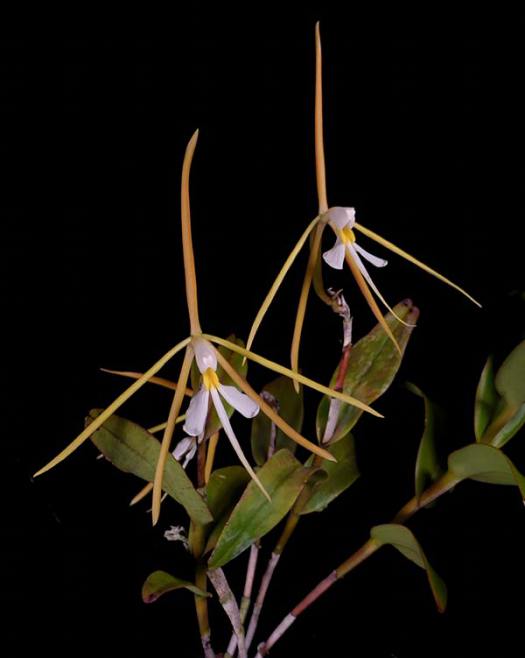
Epidendrum nocturnumThis species has a very wide range. It grows nicely in my back yard (NOT tropical) but I also saw the species in the Amazon area of Brazil (very tropical). I wonder if individual plants could adapt to such different conditions, or if individuals from different populations have different needs. |
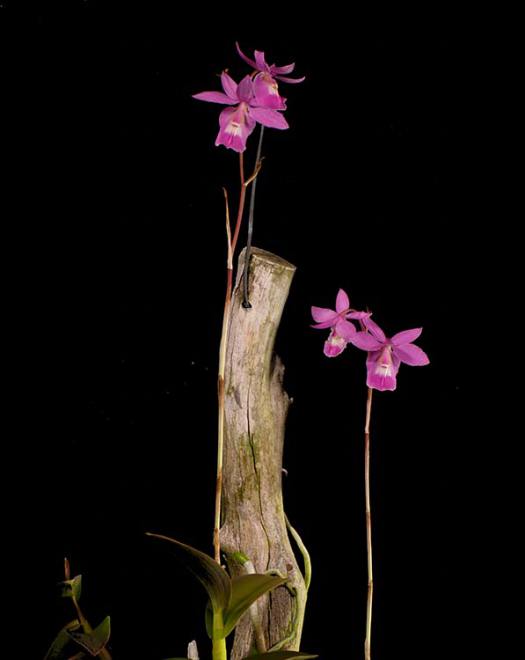 |
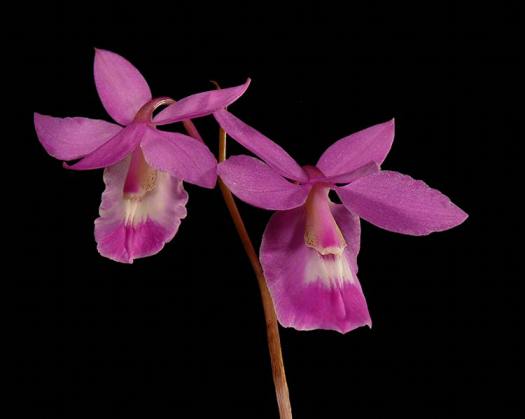
Barkeria lindleyana ssp. vannerianaBarkerias need to be grown mounted, or in a basket with little or no medium.The mount in the photo has rotted away, leaving behind a mass of roots that don't seem to miss it in the slightest. I just slipped a wire through the root ball to hang the plant. When the flowers drop, don't trim the spike until the following year when you can easily see what is really dry and brittle - the lower part of the bare spike is still very much alive, and needed by the plant. it tends to lose leaves, to make new growth the following summer/fall. |
.jpg)
Masdevallia sp. (floribunda type)Flowers are somewhat smaller than Masd. floribunda. It is just as easy to grow, being more warmth-tolerant than most Masdevallias. |
|
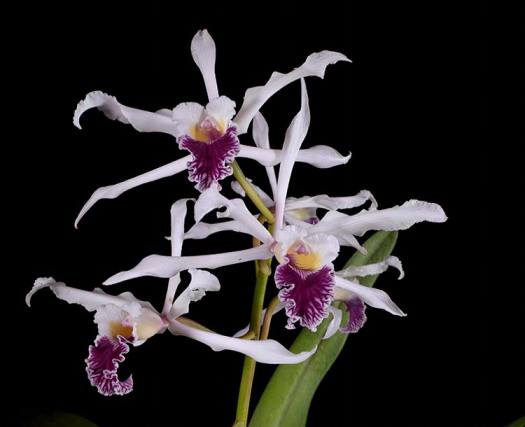
Cattleya (Laelia) crispaRelated to L. purpurata and L. tenebrosa, the last of the group to flower. Petals are narrow, but the lip is very dramatic. |

Guarianthe (Cattleya) bowringiana f. coeruleaI grow this under overhead polycarbonate cover, but it handles winter cold with no problem. When I first acquired it, I grew it in the greenhouse, but I have found that it grows better outside. |
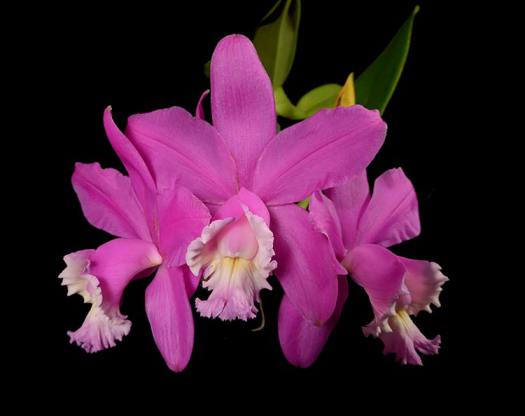
Cattleya harrisoniana 'Volcano Queen'Line-bred, maybe the pollinator would not recognize it, but it is beautiful. |
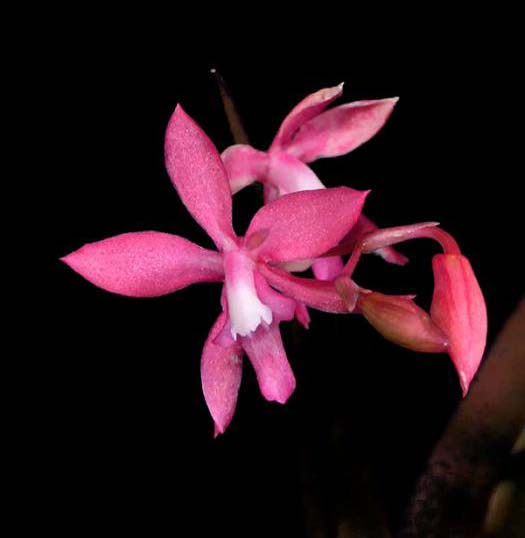
Cochlioda roseaFlowers are only about 1/2 inch, but make up for size with brilliant color. This is the second blooming this year. |
In the greenhouse... |
|
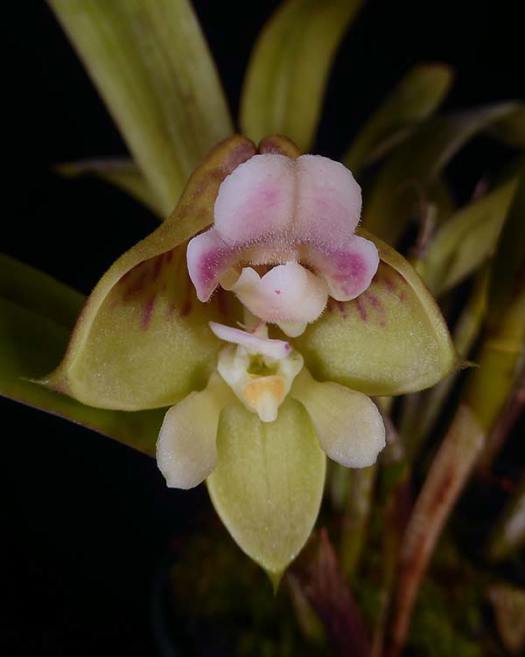 |
|
Polystachya galeataOne of the largest flowers of the genus. it is strangely asymmetrical. It produces flowers sequentially on each very short inflorescence. |
|
 |
|
Macroclinium dalstroemiiFlowers are tiny. The inflorescence reminds me of a dandelion. Each hairlike inflorescence can produce several batches of flowers, sequentially. |
|
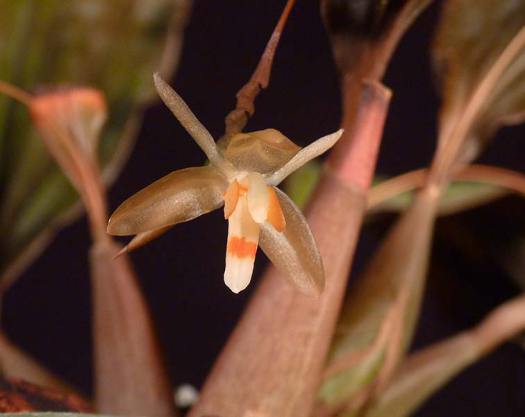 Coelogyne monilirachisThis plant is in bloom most of the time, usually one or two flowers. This month it produced a flush bloom. Each inflorescence ends in a rachis that produces many flowers sequentially. |
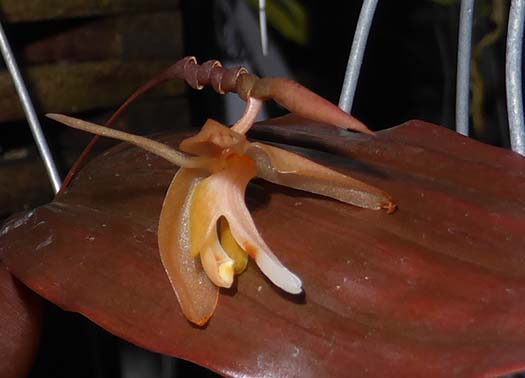 |
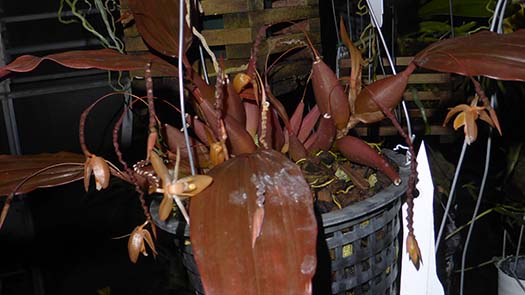 |
|
